
Volvo EX30 Twin Motor Performance 2024 review: snapshot
The Volvo EX30 is instantly recognisable as a contemporary Volvo thanks to...
Browse over 9,000 car reviews
Work and play, that's the promise of today's four-door utes. But the truth is we are increasingly using them as family cars.
Showroom displays tell the story: the latest utes are surrounded by camping and beach gear. There's not a fluro vest or a hard hat in sight.
Those who sell them say a significant number of trade-ins come from owners of Ford Falcons and Holden Commodores -- and family SUVs of all shapes and sizes.
With that in mind we picked the models most suited to the daily grind: the new Toyota HiLux SR5, the Ford Ranger XLT and the Mazda BT-50 XTR.
Having tested the best of the dozen or so offerings in the ute class earlier this year, these three pick-ups are the top of the current crop.
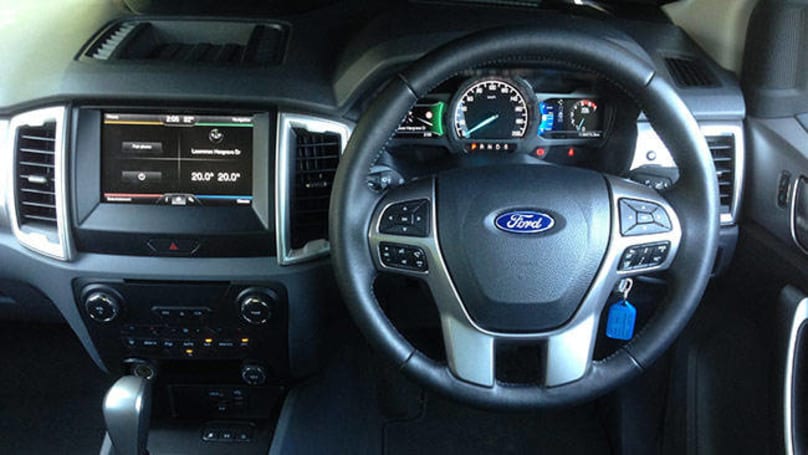
The Ford Ranger surprised everyone when the first all-new model in 17 years arrived in 2011.
Designed by the same team who styled the Ford F-150 in US and engineered in Australia -- even if it's made in Thailand with the rest of the ute pack -- the Ranger raised the bar for driving dynamics and crash safety to better reflect changing real-world use.
This update is more than just fresh metal forward of the windscreen. Ford has introduced numerous refinements to the 3.2-litre five-cylinder diesel engine and six-speed automatic transmission.
They've also turned a spanner on the suspension and switched to electric power steering, further improving the way the Ranger drives.
The interior has a new 8-inch touchscreen that will automatically call 000 if the airbags are deployed in a crash.
Aside from one notable exception -- a rear view camera is optional on 36 of 37 Ranger models -- the Ranger XLT comes fully loaded, with a factory-fitted tow bar, rear parking sensors, tray liner, sports bar with down lights, and a 12V power socket in the ute tray.
Inside, there are two USB ports and three 12V charge points, and a 230V/150W socket to power a lap top.
A rear view camera is a standalone option for $780. But we reckon the $1100 technology pack -- that bundles a camera with radar cruise control and lane-keeping technology -- is better value after we quickly got used to the convenience of distance-keeping cruise control.
Downsides? Ford knows how to charge for the Ranger. The popular XLT model is $57,620 plus on-roads with auto and optional rear camera.
Discounts are rare but they may be even harder to come by given Toyota has crept up the price of the HiLux SR5 ($57,990 plus on-roads with auto, a camera is standard).
Driven in isolation, the new HiLux is an excellent pick-up, but the Ford Ranger feels luxurious in comparison.
The Ranger has the strongest engine, is the most comfortable over bumps, feels the most secure in corners, and has a genuine 3500kg tow capacity with auto or manual transmission (the HiLux auto is restricted to 3200kg, only the HiLux manual can tow 3500kg).
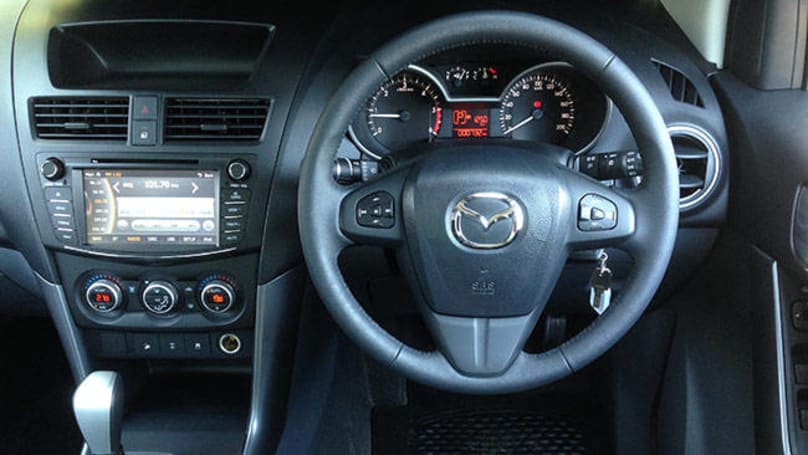
Blink and you may miss the changes to the updated Mazda BT-50: new wheels, headlights, tail-lights and grille (masked by the optional bulbar on our test car).
Inside, the centre section of the dash has a large touchscreen and a cleaner appearance.
Each of these utes has navigation as standard but the BT-50 is the only one that can integrate HEMA off-road maps, a $295 option.
The Mazda and the Ford utes were developed side-by-side, share the same chassis, and are made on the same jointly-owned production line in Thailand.
But for some reason the updated Mazda BT-50 didn't get the Ford Ranger's numerous technical upgrades and refinements. Has the relationship soured? Neither party is saying.
The BT-50 drives exactly the same as it did when it arrived four years ago. Mazda has not touched the suspension or the hydraulic power steering.
The Mazda also didn't get the Ford's subtle changes to the 3.2-litre five-cylinder diesel engine (different injectors and turbo) and six-speed auto transmission (different shift calibration), which perhaps explains why the Ranger was quicker in our 0 to 100km/h comparison.
These utes are not race cars but our acceleration tests reflect real-world performance (Ranger: 11.1 sec, BT-50: 12.1 sec, HiLux: 13.1 sec).
The Mazda BT-50 feels secure on the road, but the suspension can be choppy on bumpy surfaces. The steering feels precise on the move, but it's a little heavy at parking speeds.
Downsides? The rear-view camera is a small display in the rear-view mirror, and there is no household power socket or digital radio (standard in the other two). There are three 12V points in the cabin, but only one USB port -- in the glovebox.
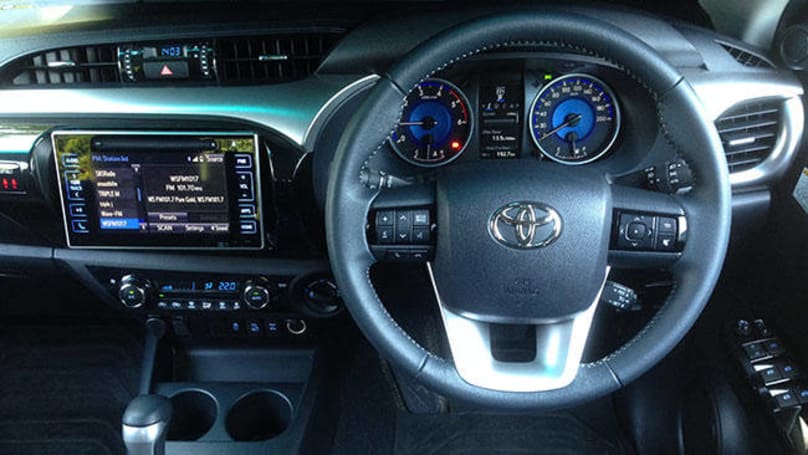
Despite its familiar appearance, this HiLux is all-new from the ground up.
The chassis is made from thicker steel, there is tougher underbody protection and it's more capable off road, with the best wheel articulation of this trio and the best entry and departure angles.
It's also the first HiLux to be extensively tested on Australian roads (650,000km, which is more than the latest Holden Commodore).
It drives like no other HiLux before it, with good road holding and grip.
But when compared back-to-back with the Ranger, the suspension can feel a little too busy over bumps and the hydraulic power steering, although light and easy, needs slightly more input to get the HiLux to take a curve.
But it makes light work of parking, in part due to its tight turning circle.
The new HiLux has the biggest front disc brakes among these three and the most precise pedal feel.
The all-new 2.8-litre turbo diesel is more efficient and more refined than before, but it has noticeably less grunt than the other pair, despite appearing close on paper.
The interior -- with a tablet-style touchscreen -- looks upmarket and has a high quality feel.
A rear view camera is standard on all HiLux pick-ups, but the guiding lines don't turn with the steering (as they do in the Ranger) and rear sensors are optional (standard on the Ranger).
The HiLux has a chilled compartment above the glovebox but only two 12V charge points and one USB.
At least the Toyota has a 220V/100W household power socket in the console (versus the Ford's 230V/150W). Despite the slight power deficit, the HiLux still recharged our laptop from empty in three hours.
These utes are the best of the breed, you can do no wrong among this trio. But we are here to rank them, not sit on the fence.
The Mazda BT-50 XT-R is a lot of truck for the money ($51,700 with auto), about $6000 less than the Ford Ranger XLT and Toyota HiLux SR5.
If all you want to do is tow, and you don't mind missing some of life's luxuries, the Mazda is a solid choice.
But the BT-50's dearer servicing, small rear camera display, relative lack of refinement and fewer standard features weighed against it.
That leaves our toughest decision all year: HiLux or Ranger?
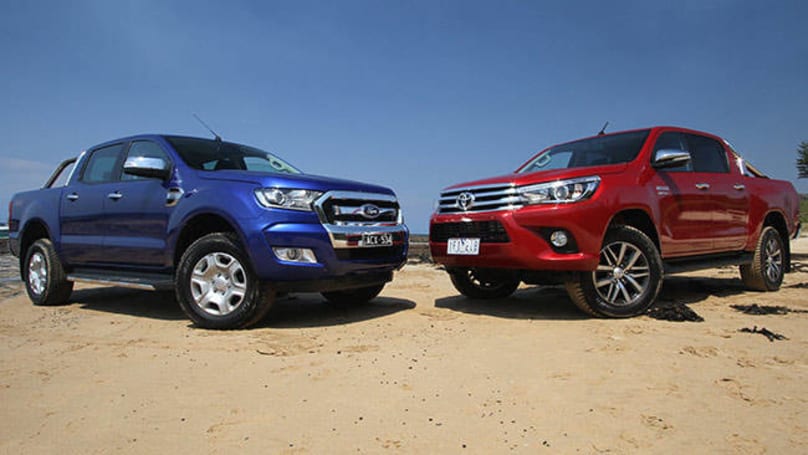
There is no doubt this is the best HiLux ever built, and is better than experts were expecting.
But the face-lifted Ford Ranger has raised the bar yet again with significant changes under the skin and inside the cabin, and that has once again put it ahead of the top-selling Toyota.
The HiLux is superior off-road, has a better reputation for resale value and reliability, and is cheaper to service.
But the Ranger is the best all-round package. It has the strongest engine, is the best to drive, and is loaded with more equipment for the same or less money -- even once an optional rear-view camera is added.
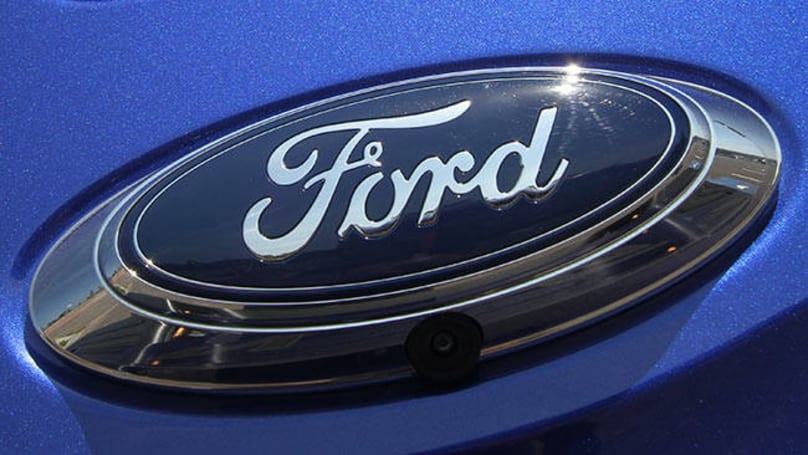
Price from: $57,620 plus on-road costs
Warranty: 3 years/100,000km
Capped servicing: $1505 over 3 years (45,000km)
Service interval: 12 months/15,000km
Safety: 5 stars, 6 airbags
Engine: 3.2-litre 5-cyl turbo diesel, 147kW/470Nm
Transmission: 6-speed auto, 4WD
Thirst: 9.0L/100km
Fuel tank: 80 litres
Dimensions: 5355mm (L), 1860mm (W), 1821mm (H), 3220mm (WB)
Turning circle: 12.7m
Approach/departure angles: 29°/21°
Weight: 2229kg
Wheels: 17 x 8.0-inch alloy
Tyres: 265/65 17 Dunlop Grand Trek
Spare: Full-size, steel rim
Towing: 3500kg
Payload: 925kg
Wading depth: 800mm

Price from: $51,700 plus on-road costs
Warranty: 2 years/unlimited km or 3 years/100,000km
Capped servicing: $2004 over 3 years (45,000km)
Service interval: 12 months/10,000km
Safety: 5 stars, 6 airbags
Engine: 3.2-litre 5-cyl turbo diesel, 147kW/470Nm
Transmission: 6-speed auto, 4WD
Thirst: 9.2L/100km
Fuel tank: 80 litres
Dimensions: 5365mm (L), 1850mm (W), 1815mm (H), 3220mm (WB)
Turning circle: 12.4m
Approach/departure angles: 28.2°/26.4°
Weight: 2105kg
Wheels: 17 x 8.0-inch alloy
Tyres: 265/65 17 Dunlop Grand Trek
Spare: Full-size, steel rim
Towing: 3500kg
Payload: 1082kg
Wading depth: 800mm

Price: $57,990 plus on-road costs
Warranty: 3 years/100,000 km
Capped servicing: $1080 over 3 years (60,000km)
Service interval: 6 months/10,000km
Safety: 5 stars, 7 airbags
Engine: 2.8-litre 4-cyl turbo diesel, 130kW/450Nm
Transmission: 6-speed auto, 4WD
Thirst: 8.5L/100km
Fuel tank: 80 litres
Dimensions: 5330mm (L), 1855mm (W), 1815mm (H), 3085mm (WB)
Turning circle: 11.8m
Approach/departure angles: 31°/26°
Weight: 2075kg
Wheels: 18 x 7.5-inch alloy
Tyres: 265/60 18 Dunlop Grand Trek
Spare: Full-size, alloy rim
Towing: 3200kg
Payload: 925kg
Wading depth: 700mm
1) Make a rear view camera standard across the range, like the Toyota HiLux;
2) Improve the departure angle by better integrating the tow bar into the chassis;
3) Improve brake pedal feel and/or front disc size;
4) Improve the turning circle;
5) The Ranger XLT has a premium price but a bargain basement sound system;
6) Make the digital speed display more prominent.
1) Improve the towing capacity of the auto to 3500kg to match rivals;
2) The new 2.8-litre turbo diesel needs more grunt;
3) Add a prominent digital speed display to the screen between the analogue dials in the instrument cluster;
4) The cabin needs more USB ports and 12V sockets;
5) Move the annoying digital radio antenna from the driver's side of the windscreen to the middle or the passenger's side;
6) Add down lights to the sports bar.
1) Fit a full size rear camera;
2) Add a digital speedometer;
3) Add a household power socket;
4) Add more USB ports;
5) Adopt some of the engine and transmission refinements from the Ford Ranger;
6) Find a way to make servicing cheaper. It's the same hardware as Ford, so why is Mazda up to 50 per cent dearer?
Comments